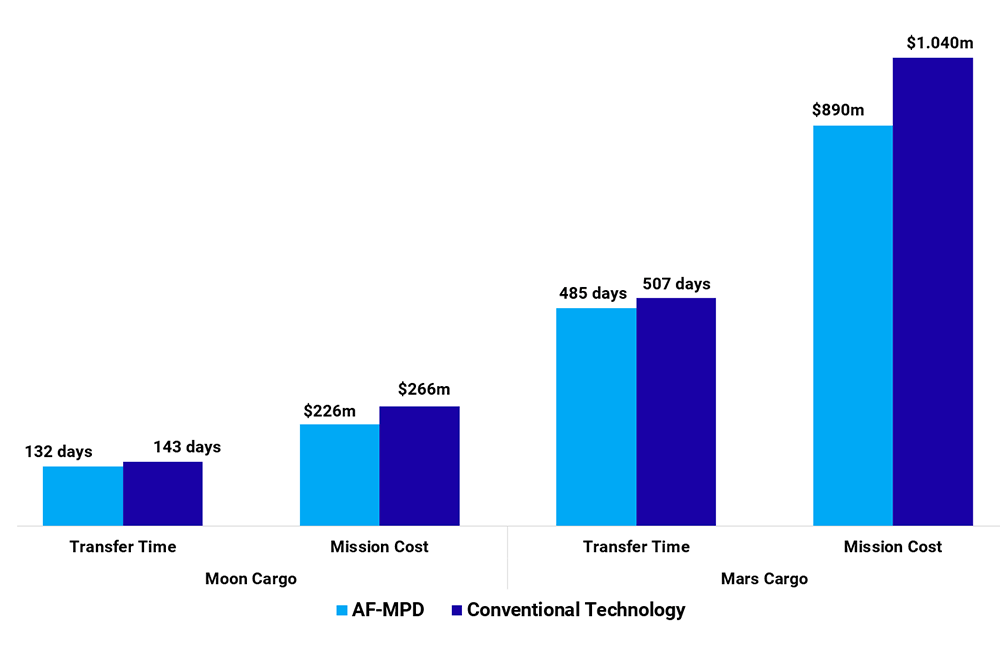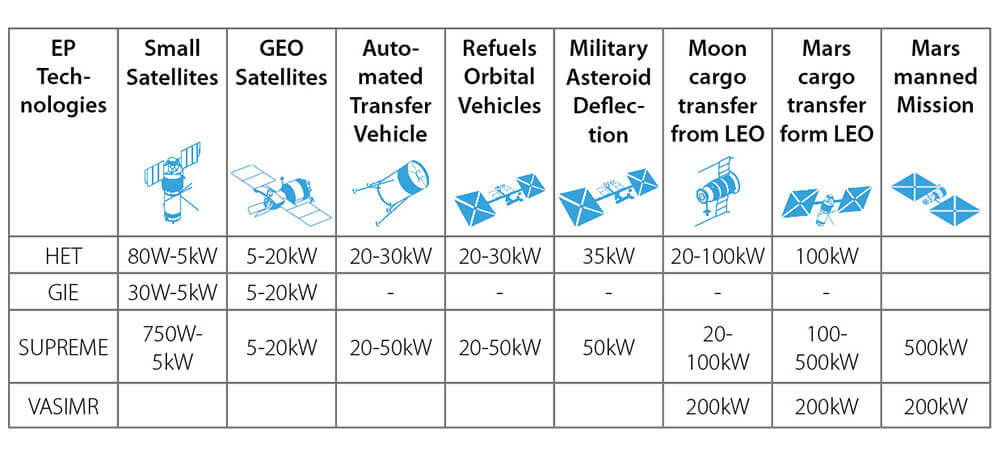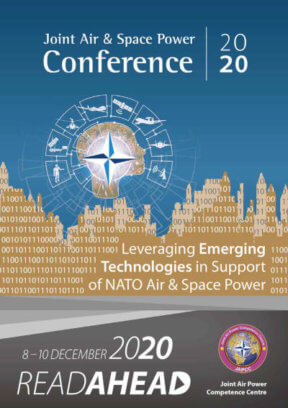The New Age of Space Situational Awareness
The critical dependence of terrestrial defence applications on space assets and satellites has positioned space as the next frontier where the struggle for global dominance will take place. The rapidly evolving nature of satellite capabilities is defining the requirements of future defence space assets while the ever-growing popularity of small satellites and satellite constellations in Low Earth Orbit (LEO) demands the consolidation of communications and monitoring satellites in Geostationary Earth Orbit (GEO). The result of such action dictates that the next generation of defence satellites will be larger and heavier, more capable, and will require more power.1
Rapidly changing conditions and situations on the ground demand responsive and versatile space assets to provide the necessary military support. For defence applications, the manoeuvrability and lifetime capabilities of these space assets are of critical importance in order to determine their responsiveness, robustness, and lifespan. Furthermore, the establishment of a consolidated yet sustainable space asset network necessitates recovery and repair systems as a contingency measure to minimize the impact of both physical and cyber-based attacks on key space assets.2 Looking ahead at the medium and long-term defence landscapes, the capacity to transport large quantities of military cargo beyond Earth to the Moon and Mars will play an important role in military space operations, and will further increase the demands on spacecraft size and power consumption. These new requirements and applications call for the utilisation of more advanced and capable propulsion technologies.
The Importance of Spacecraft Propulsion
The choice of propulsion system is key to determining the manoeuvrability and lifetime capabilities of the spacecraft, and the impact of this choice becomes even more significant as spacecraft become larger and heavier.3
Spacecraft propulsion systems can be broadly defined within two categories: Chemical (CP) and Electric Propulsion (EP) systems. Chemical systems are capable of providing high thrust to spacecraft, which enhances their manoeuvrability and responsiveness. However, they utilize fuel very inefficiently, which greatly limits their lifespan – the spacecraft can only perform a certain number of manoeuvres before running out of fuel. In addition, this greatly reduces the available payload on a spacecraft, leading to a reduction in spacecraft capability in terms of in-orbit computational power and communications, and hence reducing the effectiveness of defence against cyber-attacks.4
Electric systems, on the other hand, are far more efficient, but their low thrust limits their responsiveness and manoeuvrability. Moreover, current EP technologies rely on expensive and rare propellants, and scale poorly to higher powers, making them unsuitable for larger and heavier spacecraft due to an increase in complexity, mass, and cost. A more advanced technology, which offers greater operational flexibility and is capable of scaling to larger spacecraft, is required.
A Key New Technology
The most promising technology for these high demands is the Applied-Field Magnetoplasmadynamic (AF-MPD) Thruster, which uses a combination of magnetic and electric fields to generate thrust. This technology offers several unique characteristics, including throttleability, defined as the ability to operate over a wide range of conditions. This function enables variation in the thrust produced, providing the flexibility and versatility demanded by new space defence requirements. Meanwhile, the scalability of the technology enables applications to larger satellites while avoiding the mass and complexity penalties that limit other EP technologies. In addition to these benefits, the thruster technology is robust, offers greater thrust vectoring control, and can operate on propellants which are far cheaper and more readily-available than current options.5
For these reasons, the technology has experienced over 60 years of research heritage in 6 different countries around the world, but to date has been limited to only three spaceflight missions due to the large mass and low efficiency of the copper electromagnets used to generate the magnetic field. In contrast, High Temperature Superconductors (HTS) have reached industrial maturity and act as a key enabling technology for AF-MPD, drastically reducing the mass and power consumption of the electromagnets while increasing the efficiency and lifetime of the thruster.
The Effect on Space Operations
AF-MPD enables the responsiveness, operational flexibility and robustness demanded by the new defence environment and maximizes the effectiveness and potential of defence assets in space. For a large satellite in GEO, AF-MPD can offer high efficiency and minimal fuel consumption for standard operations, switching to a high thrust mode of operation when rapid satellite repositioning or manoeuvring is required. In the context of an in-orbit servicing vehicle, the use of AF-MPD can enable optimized spacecraft operations, leading to fuel savings and thus an increased number of servicing operations over the mission lifetime, while still offering fast responsiveness in the case of urgent operations. In-orbit servicing is among the most feasible of options to provide a recovery service to spacecraft. Spacecraft capable of offering such a service have similarly stringent requirements on operational flexibility and manoeuvrability in order to maximize their effectiveness. In the case of cargo missions, the use of AF-MPD can achieve cost and time savings on cargo transfer to the Moon by $40 million and 11 days and $150 million and 22 days for a Mars cargo scenario when compared against conventional technologies.6 These two cases indicate that AF-MPD has a highly beneficial impact on space operations and therefore defence capabilities.

The Geopolitical Background
The unique proposition offered by this technology has motivated its development as a global technology. The first activities were concentrated in Germany and the USA in the 1960s, while significant research was also conducted in Japan and Russia in the 1980s and 1990s, alongside three flight experiments proving operational capability in space. Today, the Institute of Space Systems at the University of Stuttgart in Germany, and Nagoya University in Japan, are the two main centres of MPD research worldwide. In Stuttgart, the 100kW class SX3 thruster has demonstrated the best experimental performance of any AF-MPD prototype to date.7 Despite the prominence of AF-MPD programs at NASA and the production and testing of several prototypes between 1965 and 1996, American research on the technology has diminished greatly, and the US has lost its world-leading position in AF-MPD.8
The Threat from the East
In the past decade, AF-MPD research has also taken place in Italy and China. In particular, the activities in China are increasing at a rapid rate. China has made clear its ambition to be the leader in economic and military use of outer space by 2045, and has dedicated substantial funds to building the infrastructure needed to articulate a fast-track development program.9 China has implemented a roadmap to appropriate and exploit AF-MPD technology by monitoring and analysing the work in Nagoya and Stuttgart. They have understood the challenges involved in solving the paradigm of high power in space and have already set in motion the necessary instruments to gain leadership and non-dependency with a prototype copy of the SX3 thruster at Beihang University.10 Additionally, efforts are being undertaken to develop a 500kW class thruster at the Shanghai Institute for Space Propulsion. Furthermore, they are already embarking on research into the use of HTS in their thrusters. The assessment of Prof. Georg Herdrich, the leading authority on AF-MPD technology in Europe, estimates that the Chinese will be able to attain in-orbit demonstration capabilities within 3 to 5 years.
Russia was one of the main players in R&D efforts for the technology until 2010, after which activities fell to a minimum. Nevertheless, they have achieved industrialization levels in HTS technology by gaining access to European markets. They have also developed the necessary capabilities for Nuclear Electric Propulsion, adding additional pressure on Western countries to develop similar strategies for high-power missions. Based on their continuing manpower expertise, they could articulate a program for development of the technology within 5 years. Table 1 shows the different thruster power classes and the corresponding spacecraft missions.

The Need for NATO and FIVE EYES Cooperation
The rich AF-MPD research heritage of Germany and the US, coupled with the extensive capabilities of EP and spacecraft system development across Europe and North America, means there is a decisive opening for NATO member states to achieve a dominant position in future space activities by securing AF-MPD technology.11 The FIVE EYES group is positioning itself towards this through recent developments: the establishment of the United States Space Force in 201912 and the commitment to the Lunar Gateway ARTEMIS mission (50kW)13; the endorsement of AF-MPD technology by the New Zealand Space Agency; the launching of the Moon to Mars initiative by the Australian Space Agency; and the increased focus on space applications and disruptive space technologies by the UK government in the wake of Brexit.14
In Europe, the move towards this progressive position is slowly gathering pace, with the EU recently committing €3.4 million in funding towards the development of a superconductor-based spacecraft system for re-entry shielding. Nevertheless, despite the technological maturity of the superconductor industry and the disruptive potential it provides across industries and applications, significant entry barriers have left it unable to integrate into the European space market.15 Despite the move towards high power missions, as seen in the ESA Mars Sample Return mission (40kW), the lack of an entry scenario for both HTS and AF-MPD technology in Europe threatens to allow the technology to fall into the hands of Russia or China.
It is difficult to understate the strategic implications for NATO if this technology is not developed in time. AF-MPD promises immense value for space military applications and mastering superconducting technologies will have huge impacts in aviation16, defence and naval applications17. With the arrival of the high-power market, the development of such technology is fundamental in securing a leading position in the future of space. In the past, Europe and the USA have been leaders in the development of this technology. Today, this R&D has been forced to take a back seat due to current political trends and the European and American inability to face global challenges.
It is consequently of paramount importance that NATO exercise pressure and take leadership, with the aim of mitigating the risk of losing this technology to Russia and China and minimizing the implications this would have for both the US and Europe. In other words, the western alliance cannot afford to allow potential adversaries to gain this propulsion technology before they do; NATO must lead the space race, and not simply be a part of it. It is fundamental that a joint assessment of both the technological status quo and the impacts on the space and military programmes of Europe and the USA is conducted. A combined technology review by the US, the EU and the FIVE EYES group would serve to create a favourable environment for further development of the technology, and also avert the risk that other powers gain the upper hand in the race to secure dominance in space.
Concluding Remarks
Entering into the expanse of space beyond the Earth’s atmosphere will be the next frontier in which to assert global dominance. However, such radical advancements require radical technological breakthroughs and the innovation in research to foster their development. The strategic situation is changing as nations like China discuss colonizing and claiming the Moon. AF-MPD is a strategic game-changer as space becomes the most important realm of national security from both a military and economic perspective. It is surely one of the most critical variables that will place the western alliance ahead of potential adversaries and opponents. The major parties within NATO must articulate a joint strategy to co-develop the technology together with the FIVE EYES group and, where possible, NATO countries must look at the positive impact of superconductors on their strategic advantages. For without political support, private investors will not face the risks associated with securing the technology alone. It is therefore in the interest of all NATO parties to work together to develop stronger coalitional ties regarding space policy and take the necessary steps to explore radical technologies such as AF-MPD.











